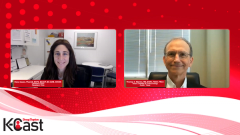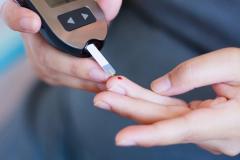
Future Directions for the Use of Biosimilars in Diabetes
Drs Thomas C. Blevins and Diana Isaacs share insight on unmet needs and the future treatment landscape of biosimilars in the treatment of patients with diabetes.
Episodes in this series

Diana Isaacs, PharmD, BCPS, BCACP, BC-ADM, CDCES: This is exciting because this is interchangeable. I feel like this is the beginning of a new era. Can you comment a little on what you think the future is with biosimilars?
Thomas C. Blevins, MD, ECNU, FACE, FNLA: In terms of biosimilars around everywhere, we’ll see. You’re talking about biosimilar insulin of course, I think.
Diana Isaacs, PharmD, BCPS, BCACP, BC-ADM, CDCES: You can comment on all biosimilars, but yes, specifically insulin. I’m curious what’s going to be in the future? We have so many types of insulin. Probably many of them are going to be coming off a patent eventually.
Thomas C. Blevins, MD, ECNU, FACE, FNLA: They are. There are biosimilar insulin asparts, the NovoLog biosimilars that have been approved by the European group. Sanofi has the biosimilar of Eli Lily’s Humalog [insulin lispro], and that’s Admelog [insulin lispro]. We have that available. It’s in Europe in tier 2. There’s another aspart that’s going to be approved from Sanofi biosimilar before long. The 1 I referred to earlier is going to be Beatrice or Mylan, and then we already have Basaglar [insulin glargine]. As soon as I go off, patent people are going to rush and biosimilar themselves to the reference.
Semglee [insulin glargine-yfgn] is going to be the leader of the interchangeability. That will become the standard, I believe. Every biosimilar will go after interchangeability, as it should. The FDA is defining what a company needs to do to get approval. It’s going to continue to refine its requirement. Remember I mentioned INSTRIDE 3? There were 3 switch periods. It might have to be more than that in the future. Who knows? But biosimilar is going to be the way of the future, and we’ll have choices. Fortunately, we have choices between them, and this biosimilar thing will lead to a lot price competition.
You mentioned that Semglee [insulin glargine-yfgn] is cheaper by 50%, and when you’re looking at numbers, perhaps 1 of the reference product manufacturers will decide to drop their price. Of course, their formulary and prices are sometimes different from what we’re talking about in terms of retail. There’s a gigantic future for biosimilars, which is a good thing. We’re talking about treating diabetes and making the lives of people with diabetes better. More affordability of good treatments makes things better and more accessible. You’ve said this already, but price can stop treatment. If good treatments aren’t affordable, then it’s not going to happen. It’s not going to happen regularly. This is all a big deal for people with diabetes.
Diana Isaacs, PharmD, BCPS, BCACP, BC-ADM, CDCES: Unfortunately, I’ve had patients rationing their insulin. It’s a much more common thing than we realized. Cutting off a few units here and there because they’re trying to conserve their insulin—that’s the saddest thing, that people feel they have to do that. We need to get the price down so people can afford these medications.
We’re wrapping up here, but you mentioned how these are not generics, right? This is a different approval process. Yet I know insulin lispro and insulin aspart have generics, I believe, made by the same exact company. It’s confusing for a lot of people. Why are those considered generics, but then these are biosimilars? How are people supposed to navigate all that?
Thomas C. Blevins, MD, ECNU, FACE, FNLA: You’re asking me to refine the definition of that. Any insulin is going to be made from a living cell. It’s a biologic, and those are biosimilars. They’re not approved under the biosimilars pathway because of the approval process change in 2020. They’re approved under what was called a follow-on biologic, which is the same thing. It’s semantics, but it’s the way the approval changes.
There’s 1 lispro, a refined lispro, that has additives. That’s the Lyumjev [insulin lispro-aabc]. That has an -aabc category after it. The Admelog doesn’t have that because it’s approved under somewhat different pathways. Those are biologics and those are biosimilars; they’re not generic. We talk about them. Generic is this concept of something that’s less expensive than the originators but really descriptive. I still talk to patients about this with what would be a biosimilar, and I say it’s like a generic because it’s descriptive. It makes people understand it better. Being strict to terms, those are biosimilars, and they’re not approved as a biosimilar. They’re biosimilars. Generics could be like aspirin, salicylic acids, and statins. Those are small molecules, and they’re easy to make. These are derived from either yeast, bacteria, or living organisms.
Diana Isaacs, PharmD, BCPS, BCACP, BC-ADM, CDCES: I bring it up because there’s a ReliOn insulin aspart that’s available at Wal-Mart. Sometimes patients may get that instead of their usual branded NovoLog [insulin aspart]. We’re seeing things substituted, and it’s important to highlight that it’s all similar. It’s expected to have the same effect, and people should not be alarmed. In fact, they should be happy because they’re going to save the cost. It’s going to be more accessible. Hopefully, that will lead to better clinical outcome.
We’ve talked about a lot of great information. Tom do you have a closing remark that you want to leave the audience with?
Thomas C. Blevins, MD, ECNU, FACE, FNLA: I enjoyed the discussion. Our job is to make the lives of people with diabetes better—controlling their diabetes, preventing complications. We want to use meds that we’re familiar with, and we want to get control of the diabetes effectively. In the insulin world, hormonal replacement, we want to simulate the physiology. Having a product—the basal, in particular—that’s less expensive, perhaps more available for our patients and conceptually for anyone, anywhere. That’s a big deal, so this interchangeability is a big deal. I’ll leave you with that final comment.
Diana Isaacs, PharmD, BCPS, BCACP, BC-ADM, CDCES: I love it. I totally agree. This is great news for diabetes. What I want to leave everyone with is, please educate your colleagues and your patients about it. Let people know this is a good thing for diabetes. Hopefully it will help people feel better and lead to the best-possible clinical outcomes by helping remove a barrier, which is cost. With that, I want to thank you all for watching this Endocrinology Network® Drug Topics presentation. We hope you found this presentation to be rich an informative. I wish you all a wonderful day. Thank you.
Thomas C. Blevins, MD, ECNU, FACE, FNLA: Thanks, Dr. Isaacs. Thanks, everyone.
Transcript Edited for Clarity
Newsletter
Pharmacy practice is always changing. Stay ahead of the curve with the Drug Topics newsletter and get the latest drug information, industry trends, and patient care tips.

















































































































